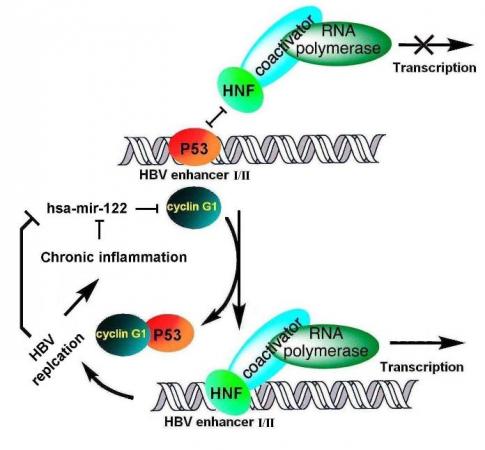全世界有3.5亿人慢性感染乙肝病毒(HBV),在我国感染人群约9300万,乙肝慢性引起急、慢性病毒性肝炎,与肝纤维化、肝癌的发生发展密切相关,严重威胁人类的健康。病毒感染人体后病毒与宿主之间的相互作用决定感染的结局和疾病转归,然而,迄今为止病毒逃逸宿主防御及乙肝慢性化机制并不清楚,因此,研究病毒与宿主因子相互作用及病毒持续感染的分子机制将有助于设计治疗慢性乙肝的新的靶向药物。

乙肝慢性感染中通过miR-122-cyclin G1/p53-病毒增强子通路促进病毒的表达与复制
microRNA-122 (miR-122)在肝脏中特异性表达而且是肝细胞中丰度最高的小RNA,在肝脏功能和病理中发挥重要作用。微生物所孟颂东研究员课题组新近的研究发现miR-122作为宿主限制性因子明显抑制病毒复制,而在乙肝慢性感染中由于慢性炎症和病毒感染引起miR-122下调,进一步研究查明miR-122通过cyclin G1/p53通路对病毒复制起调控作用。基于以上研究课题组提出乙肝感染慢性化的新机制:乙肝慢性感染下调宿主限制性小RNA,通过miR-122-cyclin G1/p53-病毒增强子通路促进病毒的表达与复制。这为进一步了解HBV病毒的持续感染机制和肝癌发生途径提供了新的依据和阐释,同时提出miR-122作为治疗慢性乙肝的潜在新一代药物的可行性。
该项研究成果在线发表在Hepatology杂志上。“973”、国家自然基金等项目资助了该研究课题。

 Loss of MiR-122 expression in patients with hepatitis B enhances hepatitis B virus replication through cyclin G1 modulated P53 activity
Loss of MiR-122 expression in patients with hepatitis B enhances hepatitis B virus replication through cyclin G1 modulated P53 activity
Saifeng Wang, Lipeng Qiu, Xiaoli Yan, Wensong Jin, Yanzhong Wang, Lizhao Chen, Erjie Wu, Xin Ye, George F Gao, Fusheng Wang, Yu Chen, Zhongping Duan, Songdong Meng
Hepatitis B virus (HBV) causes chronic infection in about 350 million people worldwide. Given the important role of the most abundant liver-specific microRNA miR-122 in hepatic function and liver pathology, here we investigated the potential role and mechanism of miR-122 in regulating HBV replication. We found that miR-122 expression in liver was significantly down-regulated in patients with HBV infection compared with healthy controls, and the miR-122 levels were negatively correlated with intrahepatic viral load and hepatic necroinflammation. The depletion of endogenous miR-122 by its antisense inhibitor led to enhanced HBV replication whereas over-expression of miR-122 by transfection of mimic or its expression vector inhibited viral production. We next identified cyclin G1 as a miR-122 target from multiple candidate target genes which is involved in the regulation of HBV replication. Over-expression and knock-down studies both showed that cyclin G1 regulated viral replication in HBV transfected cells. We also observed that cyclin G1 expression was up-regulated in HBV infected patients, and cyclin G1 levels were inversely associated with miR-122 expression in liver tissues. Using co-immunoprecipitation, luciferase reporter system and electrophoretic mobility shift assay (EMSA), we further demonstrated that cyclin G1 specifically interacted with p53, and this interaction blocked the specific binding of p53 to HBV enhancer elements and simultaneously abrogated p53-mediated inhibition of HBV transcription. Finally, we showed miR-122 suppressed HBV replication in p53 wild-type cells but not in null isogenic cells. Conclusion: miR-122 down-regulates its target cyclin G1, thus interrupts interaction between cyclin G1 and p53, and abrogates p53-mediated inhibition of HBV replication. Our work showed that miR-122 down-regulation induced by HBV infection can impact HBV replication and possibly contribute to viral persistence and carcinogenesis.
文献链接:https://onlinelibrary.wiley.com/doi/10.1002/hep.24809/abstract







